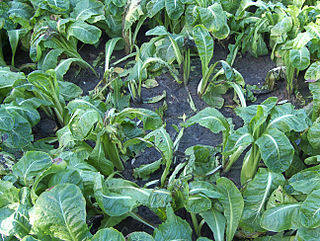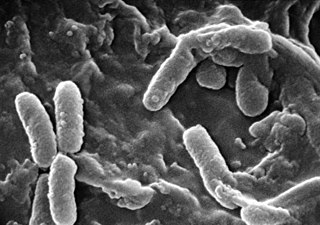Pseudomonas fragi is a psychrophilic, Gram-negative bacterium that is responsible for dairy spoilage. Unlike many other members of the genus Pseudomonas, P. fragi does not produce siderophores. Optimal temperature for growth is 30 °C, however it can grow between 0 and 35 °C. Based on 16S rRNA analysis, P. fragi has been placed in the P. chlororaphis group.
Pseudomonas ficuserectae is a nonfluorescent, Gram-negative, soil bacterium that causes bacterial leaf spot on a Japanese fig, from which it derives its name. Based on 16S rRNA analysis, P. ficuserectae has been placed in the P. syringae group.

Pseudomonas marginalis is a soil bacterium that can cause soft rots of plant tissues. It infects poinsettia, lettuce, and crucifers.
Pseudomonas anguilliseptica is a Gram-negative bacterium that is pathogenic to fish. It was first isolated from Japanese eels. Based on 16S rRNA analysis, P. anguilliseptica has been placed in the P. aeruginosa group.
Pseudomonas flavescens is a Gram-negative bacterium that causes blight cankers on walnut trees. Based on 16S rRNA analysis, P. flavescens has been placed in the P. aeruginosa group.
Pseudomonas mosselii is a Gram-negative, rod-shaped, bacterium clinically isolated in France. Based on 16S rRNA analysis, P. mosselii has been placed in the P. putida group.
Pseudomonas synxantha is a fluorescent rhizosphere bacterium with nematicidal properties. Based on 16S rRNA analysis, P. synxantha has been placed in the P. fluorescens group.
Pseudomonas straminea is a Gram-negative, rod bacterium that includes strains formerly identified as P. ochracea. Based on 16S rRNA analysis, P. straminea has been placed in the P. aeruginosa group.
Pseudomonas taetrolens is a Gram-negative, nonsporulating, motile, rod-shaped bacterium that causes mustiness in eggs. Based on 16S rRNA analysis, P. taetrolens has been placed in the P. chlororaphis group.
Pseudomonas monteilii is a Gram-negative, rod-shaped, motile bacterium isolated from human bronchial aspirate. P. monteilii grows in temperatures below 40 degrees Celsius. The species is capable of respiratory metabolism, but not fermentative metabolism. Laboratory observations were made on the species' production of fluorescent pigments, cytochrome oxidases, and catalases. The species is named in honor of the French microbiologist Henri Monteil.
Pseudomonas cedrina is a Gram-negative, rod-shaped bacterium isolated from spring waters in Lebanon. Based on 16S rRNA analysis, P. cedrina has been placed in the P. fluorescens group.
Pseudomonas orientalis is a Gram-negative, rod-shaped bacterium isolated from spring waters in Lebanon. Based on 16S rRNA analysis, P. orientalis has been placed in the P. fluorescens group.
Pseudomonas mandelii is a fluorescent, Gram-negative, rod-shaped bacterium isolated from natural spring waters in France. Based on 16S rRNA analysis, P. mandelii has been placed in the P. fluorescens group.
Pseudomonas migulae is a fluorescent, Gram-negative, rod-shaped bacterium isolated from natural mineral waters in France. This bacterium has also been isolated from endophytic tissues of lodgepole pine trees growing on gravel mining sites with potential to perform biological nitrogen fixation and plant growth promotion. Based on 16S rRNA analysis, P. migulae has been placed in the P. fluorescens group.
Pseudomonas gessardii is a fluorescent, Gram-negative, rod-shaped bacterium isolated from natural mineral waters in France. Based on 16S rRNA analysis, P. gessardii has been placed in the P. fluorescens group.
Pseudomonas rhodesiae is a Gram-negative, rod-shaped bacterium isolated from natural mineral waters. Based on 16S rRNA analysis, P. rhodesiae has been placed in the P. fluorescens group.
Pseudomonas azotoformans is a Gram-negative bacterium that infects cereal grains—especially rice. Based on 16S rRNA analysis, P. azotoformans has been placed in the P. fluorescens group.
'Pseudomonas' boreopolis is a species of Gram-negative bacteria. Following 16S rRNA phylogenetic analysis, it was determined that 'P.' boreopolis belonged in the Xanthomonas—Xylella rRNA lineage. It has not yet been further classified.
'Pseudomonas' carboxydohydrogena is a species of Gram-negative bacteria. Following 16S rRNA phylogenetic analysis, it was determined that 'P.' carboxydohydrogena belonged in the Bradyrhizobium rRNA lineage. It has not yet been further classified.

Pseudomonas infection refers to a disease caused by one of the species of the genus Pseudomonas.

